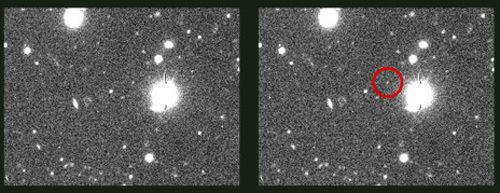Semi-major axis 46.705 Gm Orbital period −9128.74 d(24.9 a) dimensions {{{dimensions}}} | Inclination 137.679° Mean diameter 38 km Discovered 29 August 2003 Eccentricity 0.4617 | |
 | ||
Discovered by Scott S. SheppardDavid C. JewittJ. Kleyna Similar John J Kavelaars discoveries, Neptune moons, Other celestial objects | ||
Psamathe (/ˈsæməθiː/ SAM-ə-thee; Latin: Psamathē; Greek: Ψαμάθη), also known as Neptune X, is a retrograde irregular satellite of Neptune. It is named after Psamathe, one of the Nereids. Psamathe was discovered by Scott S. Sheppard and David C. Jewitt in 2003 using the 8.2 meter Subaru telescope. Before the announcement of its name on February 3, 2007 (IAUC 8802), it was known by the provisional designation S/2003 N 1.
Psamathe is about 38 kilometers in diameter. It orbits Neptune at a distance of between 25.7 and 67.7 million km (for comparison, the Sun-Mercury distance varies between 46 million and 69.8 million km) and requires almost 25 Earth years to make one orbit. The orbit of this satellite is close to the theoretical stable separation from Neptune for a body in a retrograde orbit. Given the similarity of Psamathe's orbital parameters with Neso (S/2002 N 4), it was suggested that both irregular satellites could have a common origin in the break-up of a larger moon. Both are further from their primary than any other known moon in the Solar System.
